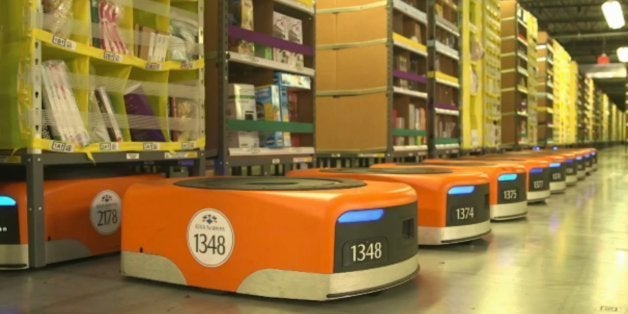
A year ago, Jeff Bezos, Amazon's founder and CEO, took "60 Minutes" contributor Charlie Rose into a top-secret room at the company's Seattle campus and unveiled his plan to use drones to deliver packages.
For the next 24 hours, Amazon’s drone ambitions -- although nowhere near a reality yet -- dominated the news. There were countless articles about the program, including several on this website, where Amazon's drones were at one point the lead story.
The "60 Minutes" segment appeared, not coincidentally, on the eve of Cyber Monday, when online shopping typically reaches a fever pitch. On Cyber Monday 2013, Amazon, the largest online retailer in the world, succeeded in becoming the story, ensuring that almost anyone who checked Facebook or Twitter, listened to the radio or watched TV, or fired up a tablet, computer or smartphone to shop online that day would hear about the company's high-tech ambitions.
The goal, obviously, was to drum up buzz for Amazon -- to keep the company foremost in shoppers' minds at the start of its most important season of the year. It was, as I wrote at the time, “one giant commercial” for the retailer.
And it seems to have worked. Amazon said that customers ordered a record-breaking 426 items per second on Cyber Monday last year.
This year, Amazon appears to be trying the same thing again -- only this time, it’s with robots. The company recently invited a select group of journalists -- I was not one of them -- to tour one of its California warehouses and watch robots move 750-pound shelves of products. Amazon says it uses 15,000 such robots in its facilities, and that the machines, a result of Amazon’s $750 million purchase of robot-maker Kiva Systems in 2012, will cut costs, save you money and help get products to you faster.
News of the robots did not come as a complete surprise this week. Since its acquisition of Kiva, Amazon has made occasional remarks about its plans to incorporate robots, and The Wall Street Journal's Greg Bensinger reported on the company's use of robots in detail on Nov. 19. Still, Amazon has had little to say on the subject -- a company representative declined to comment for Bensinger's article -- until this past Monday, when a flood of news coverage from various publications appeared just after midnight. The timing suggests that the news was "embargoed," a term for the common media practice of agreeing not to publish certain information until a certain time.
Both MSNBC and Bloomberg did multiple TV reports from the California warehouse on Monday, providing updates on the robots -- a technology that Amazon uses in only 10 of its 109 fulfillment centers worldwide, all of them in the U.S., according to the Associated Press.
All of this comes as Amazon is girding for a busy holiday shopping season. The company has disappointed investors this year, with stock down almost 17 percent over the last 12 months. On Monday, the credit rating service Moody’s lowered its outlook on Amazon from “stable” to “negative” due to the news that the company was issuing new debt.
In the press release announcing the status change, Moody’s Vice President Charlie O’Shea pointed out that Amazon faces “increased competition from brick-and-mortar retailers as they morph their successful businesses online.”
But brick-and-mortar stalwarts like Target, Walmart and The Home Depot typically don’t receive a wave of positive media attention just ahead of Black Friday and Cyber Monday.
Amazon's strategy of offering a carefully timed peek into its notoriously secretive operations ends up getting people to focus on the company's innovative practices, rather than any of the less flattering reasons Amazon has been in the news lately.
For instance, there’s a case currently in front of the Supreme Court about whether Amazon's warehouse workers should be paid for the time they have to stand around waiting to be searched for stolen items after their shifts are over. And there's Kivin Varghese, a former Amazon employee now on a hunger strike outside the company's Seattle headquarters, demanding better working conditions in Amazon warehouses.
But people love to gawk at new technology, and by showing off its drones and robots at the start of the holiday shopping season, Amazon gets to remind people that it is as much a tech company as it is a retailer -- while at the same time getting lawsuits and strikes out of the news.
It’s a pretty savvy approach. The company has 364 days to figure out what’s on tap for next year.
Amazon did not respond to a request for comment Monday about its media strategy.
CORRECTION: A previous version of this article stated that "there was no news of Amazon's robot fleet until just after midnight on Monday [Dec. 1]." In fact, earlier news coverage had mentioned the company's plans to use robots, and The Wall Street Journal reported in detail on the matter on Nov. 19.